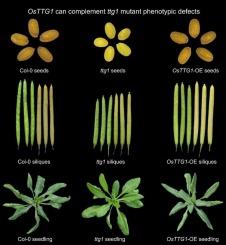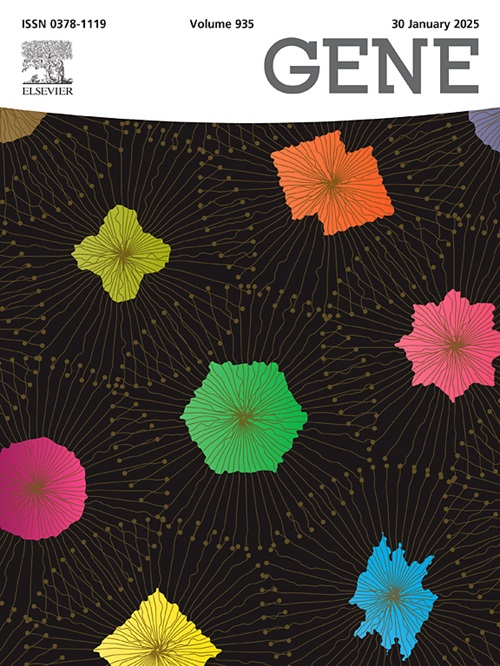Overexpression of OsTTG1 influences seed size and silique length in Arabidopsis thaliana
IF 2.4
3区 生物学
Q2 GENETICS & HEREDITY
引用次数: 0
Abstract
Seed size is a critical factor affecting seed yield and has been one of the primary objectives of plant breeders since the domestication of crop plants. In Arabidopsis (Arabidopsis thaliana (L.) Heynh.), TRANSPARENT TESTA GLABRA1 (AtTTG1, At5G24520) has been confirmed to be associated with seed size. However, whether Oryza sativa TRANSPARENT TESTA GLABRA 1 (OsTTG1, LOC_Os02g45810) affects seed size has not been reported. In this study, we obtained A. thaliana transgenic lines expressing OsTTG1 via the floral dip method. We found that OsTTG1 effectively restored the defective phenotypes of small seeds and short siliques exhibited by this mutant. Compared with the ttg1 mutant, A. thaliana seeds from the OsTTG1-OE lines showed significantly increased grain length (2–56 %), grain width (3–55 %), 100-grain weight (19–58 %), silique length (15–33 %), and the number of seeds per silique (11–73 %) compared with the ttg1 mutant. In contrast, there were no significant differences between the OsTTG1-OE strain and the wild type for any of the traits, except for slightly smaller grain length and width. These results suggest that OsTTG1 plays an important role in the regulation of seed and silique development. To further investigate the mechanism by which OsTTG1 influences seed size and silique length, we performed RNA-seq analysis on samples from the early, middle, and late pod-setting stages of the three genotypes. In |log2 (Fold Change) | ≥ 1 and the adjusted P-value < 0.05, we identified multiple DEGs (CYP72C1, CYP78A5, CYP78A9, ABI5, STK, TTG2, MEA, MET1, RR21, AP2) that may be related to seed size and silique length. OsTTG1 may directly or indirectly affect the expression of the above genes, which in turn affects seed size. Altogether, our results demonstrate that OsTTG1 can positively regulate seed size and silique length.

OsTTG1的过表达影响拟南芥种子的大小和叶鞘长度。
种子大小是影响种子产量的关键因素,自作物驯化以来一直是植物育种家的主要目标之一。拟南芥(Arabidopsis thaliana, L.)Heynh.), TRANSPARENT TESTA GLABRA1 (AtTTG1, At5G24520)已被证实与种子大小有关。然而,Oryza sativa TRANSPARENT TESTA GLABRA 1 (OsTTG1, LOC_Os02g45810)是否影响种子大小尚未见报道。本研究通过花浸法获得了表达OsTTG1的拟南芥转基因株系。我们发现,OsTTG1有效地恢复了该突变体表现出的小种子和短硅片的缺陷表型。与ttg1突变体相比,OsTTG1-OE系的塔利纳种子粒长(2-56 %)、粒宽(3-55 %)、百粒重(19-58 %)、角长(15-33 %)和每角长种子数(11-73 %)显著增加。相比之下,OsTTG1-OE品系与野生型除了粒长和粒宽略小外,其他性状均无显著差异。这些结果表明,OsTTG1在种子和花萼发育中起着重要的调控作用。为了进一步研究OsTTG1影响种子大小和果实长度的机制,我们对三种基因型的早、中、晚结荚期样品进行了RNA-seq分析。在|log2 (Fold Change)中|≥1和调整后的p值
本文章由计算机程序翻译,如有差异,请以英文原文为准。
求助全文
约1分钟内获得全文
求助全文
来源期刊

Gene
生物-遗传学
CiteScore
6.10
自引率
2.90%
发文量
718
审稿时长
42 days
期刊介绍:
Gene publishes papers that focus on the regulation, expression, function and evolution of genes in all biological contexts, including all prokaryotic and eukaryotic organisms, as well as viruses.
 求助内容:
求助内容: 应助结果提醒方式:
应助结果提醒方式:


